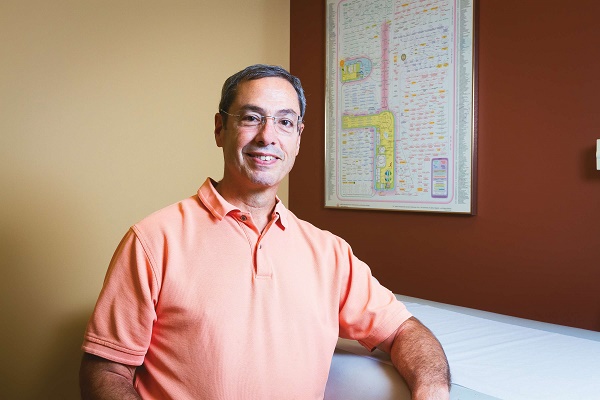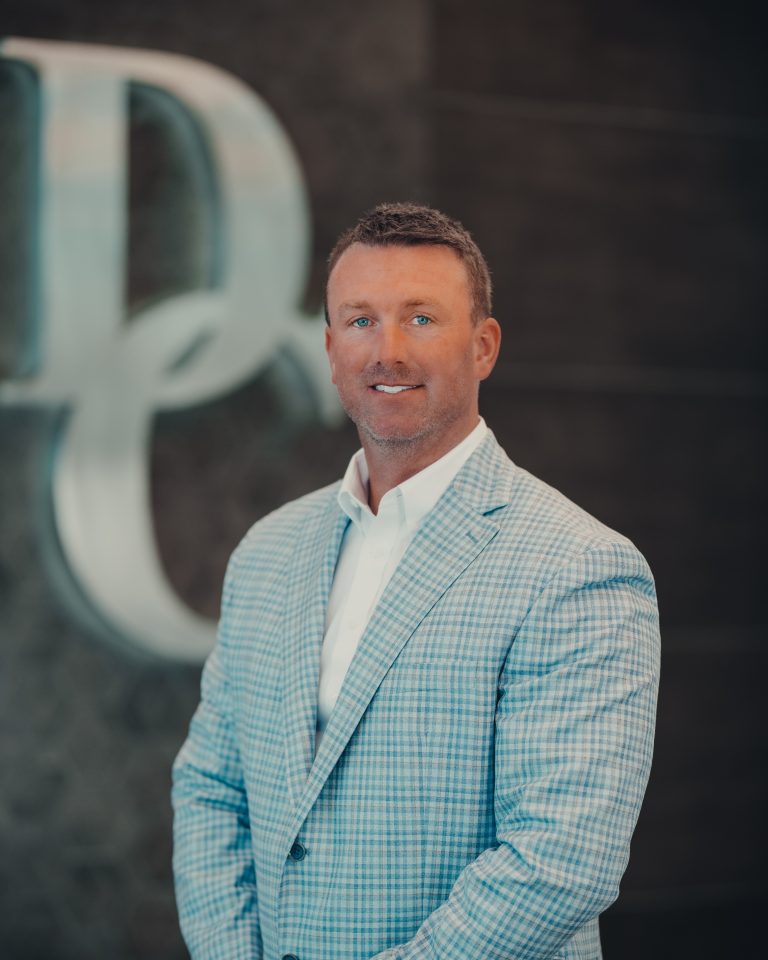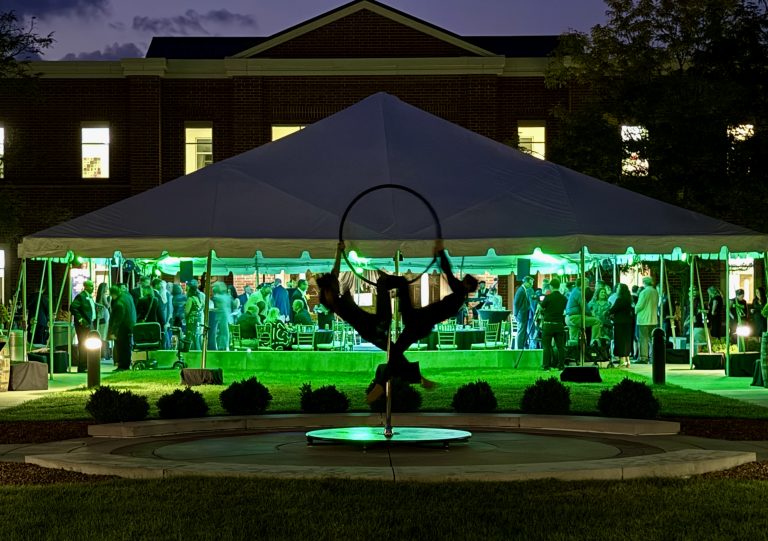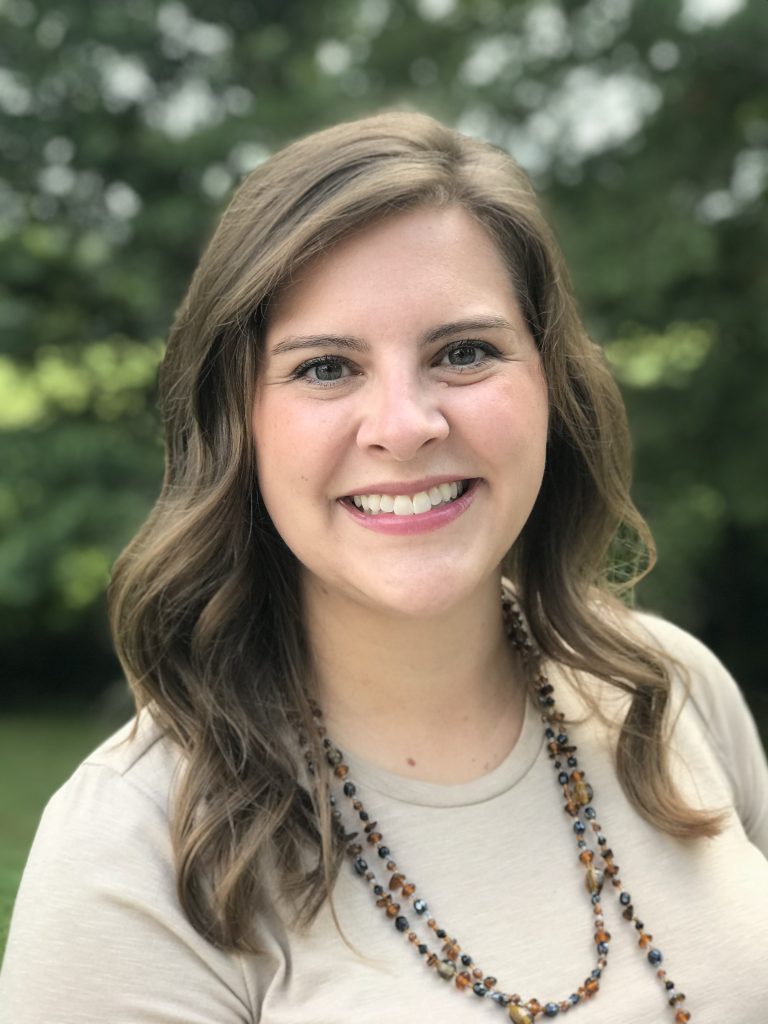
Jeffersonville pain specialist Dr. Michael Massaro knows the questions to ask before he makes the hurt go away
Most doctor ask, “Where does it hurt?” Dr. Michael Cassaro wants to know why it hurts.
Cassaro is a Pain Relief Specialist. These are the doctors who make the pain disappear. But first, Cassaro determines the reason the pain is there to begin with. As such, Cassaro is a physician, pharmacologist, nutritionist, dietician, behavioral counselor, physical therapist, occupational therapist, even psychologist, all wrapped up in a man who came out of medical school and residency as an anesthesiologist.
“I really liked anesthesiology when I was going through my rotations at the University of Louisville School of Medicine,” he says, “and so I did my residency in anesthesiology at the Ochsner Medical Center in New Orleans.”
He was an anesthesiologist, he says, but also “a people person,” and therein was the rub. “I prefer working with people who are conversant, who appreciated what I was doing,” he says. “In anesthesiology, all my patients were asleep.”
As a pain relief specialist, he doesn’t have to worry about his patients’ appreciation. There are few things more immediately rewarding for afflicted people than having their pain go away.
A Medical Engineer
Cassaro’s affinity for medicine started long before med school. He earned an undergraduate degree in civil engineering at Louisville’s J.B. Speed School of Engineering, which he says is not so far removed a discipline from medicine as it might seem.
In fact, he says, “I consider myself an engineer even today. The human body is an engineering marvel and, as with any piece of machinery that has a lot of moving parts, things can go wrong. It’s the engineer who’s uniquely trained to figure out, first, what the problem is. I’ve taken that approach to treating my patients.”
Pain relief is an especially important part of today’s medicine. More people are suffering from degenerating joints and other painful complications, exactly at a time when the government is cracking down on almost all prescription pain medications.
It helps control a worsening opioid epidemic, but it leaves legitimately suffering people with limited options. Cassaro, who operates the Painless Living treatment center in Jeffersonville, uses a great many tools in what he calls “my bag of tricks,” but he does not write prescriptions for pain medicine.
“When I tell people I don’t prescribe pain medicine, I end up seeing the people who want to get well instead of the people who kind of like being sick. Then we’re all on the same page.”
He Knows Pain
Why a pain relief specialist? Why not go to another specialist – the orthopedist or neurologist or rheumatologist – who’s familiar with your condition?
Because, says Cassaro, “most specialists don’t have specific experience or knowledge or training to draw from in treating pain, just as I wouldn’t fee comfortable providing operating room anesthesia after being away from it for about twenty years. If their patient has pain, they’ll prescribe pain medication. But when that medication is no longer doing a good job, they don’t have a Plan B. So they send their patients to somebody who does.”
That’s when Cassaro digs deep into a patient’s lifestyle, eating habits and chemical makeup.
You Are What You Eat
Take the chronic daily headaches that incapacitate so many people.
“In my 30 years of practice, almost everyone I’ve seen with chronic headaches also has digestive problems,” Cassaro notes.
Those digestive problems might include irritable bowel syndrome (IBS), which starts with heartburn. “A lot of the newer medications that treat heartburn actually make the problem worse,” says Cassaro. “Their digestive problems actually get worse because they no longer have the acid to prepare the food properly for digestion in the intestines.”
That leads to nutritional problems, not absorbing nutrients properly in the body, which show up as a variety of symptoms – and a chronic headache is one of those.
“We’re not a bag of unassembled parts,” the physician says. “Everything is connected to everything else. Everything is important for something else to work properly.”
Dealing With Arthritis
One of the most common sources of pain is arthritis, the painful stiffness, swelling and inflammation of joints – fingers, wrists, hands, knees, hips, ankles, heels and toes.
Many people suffer from it, Cassaro notes, but there are differences. What he tries to determine is what’s going on in that particular patient that promotes inflammation more easily or makes the nervous system more irritable, so that a little bit of painful stimulation gets translated into a lot of pain.
As an example, he says, “If you drive past a local golf course, you’re likely to see 80-year-old men walking the course. They have big knobby knees and hands that look like they couldn’t grasp anything, let alone a golf club. If you look at the X-rays of their joints, you’ll see they look horrible, with all kinds of arthritis. And yet, they’re walking the course, playing golf.”
Then, he says, are people in their 40s. Their X-rays don’t look that bad and yet they’re crippled with painful arthritis. That means there’s a lot more to the infirmity than just what the X-rays looks like.
“The goal is to change the metabolism of that crippled 40-year-old to be more like the active 80-year-old.
Eat, Sleep and Stay Moving
Cassaro says there are three big lifestyle components to the degree of pain from chronic everyday arthritis:
- How you eat
- How you sleep
- How you exercise
“Nutrition probably plays the biggest role,” he says, “though all three are important.”
The biggest problems of the average pain sufferer’s diet regimen are sugar and flavor-enhancers.
“Sugar is an irritant,” he says, “Ever had a cavity and eaten a candy bar? Then you know what an irritant sugar can be.”
Eating a lot of sugar makes everything in the body hurt worse. That also goes for those flavor-enhancers, preservatives and monosodium glutamate (MSG) found in restaurant foods and prepared foods. “Those are designed to light up your taste buds,” says Cassaro. “But what about after you swallow? They go around your system lighting up everything else. And if you have arthritis or nerve injury, and these chemicals are lighting things up, you’re going to have pain.”
Here, Cassaro turns nutritionist, helping patients come up with a diet altering game plan. “If people can convert their diets gradually, over time they’ll realize big changes.”
Exercise is a relatively straightforward component of the game plan: If you’re in motion, he says, you tend not to hurt as much. “Anyone with arthritis will tell you the hardest thing they do every morning is getting out of bed. But once they’re up and moving, the pain isn’t as bad. So the idea is to just stay moving.”
Sleep, however, is a hidden menace – more specifically, lack of sleep. “In the modern lifestyle, people cheat sleep,” the doctor says. “They’re up early in the morning, trying to get a headstart on work. And they’re up late at night, trying to keep things from unraveling the next morning. In so doing, they rob themselves of sleep on a long-term basis, and that promotes inflammation plus a lot of other health problems.”
The Treatment Tools
So, how does Dr. Cassaro treat chronic pain? In several ways. Here are some of the most common:
Injections. He’ll inject cortisone or an anti-inflammatory in an affected joint, perhaps also in the spine, but he has a wide variety of medications he injects. “It’s not so much what I’m injecting as where I’m injecting it,” he says. “They’re precision injections, going directly to where they’ll provide the greatest benefit – and with minimal side-effects.”
Implanted devices that interfere with pain signaling in the sensory nerves. One is a nerve stimulator, either inside the spinal canal to stimulate the spinal cord or over a nerve to perform what’s called “peripheral nerve stimulation.” Wires overlay pain pathways, and signals are broadcast through the wire to interfere with the pain signal. This is a surgical procedure, “but if you have pain that’s not responding to other treatments, this can be life-changing,” says Cassaro.
Radiofrequency ablation (RFA) heats up small areas of nerve tissue through an electrical current produced by a radio wave. This burning of sensory nerves is particularly effective in major joints like the hips and knees, or along the spine, places where the sensory and motor nerves are separate. “This is also very effective on the face,” says Cassaro, “for painful conditions like trigeminal neuralgia.”
Before You Go
Most of the Painless Living treatments are covered by insurance. For those that are not, or when an insured patient’s high deductibles cover very little of the cost of the treatment, Cassaro offers separate “cash prices.”
Painless Living is located at: 200 Missouri Ave. in Jeffersonville To make an appointment, or for more information, call 812.207.2092 or visit the website www.painlessliving.net.
You can also hear – and ask questions of – Dr. Cassaro every Saturday morning on his informational, call-in radio show, “The Painless Living Show,” which is live from the Painless Living Studios from 11 a.m. to noon on 970 AM WGTK.




















